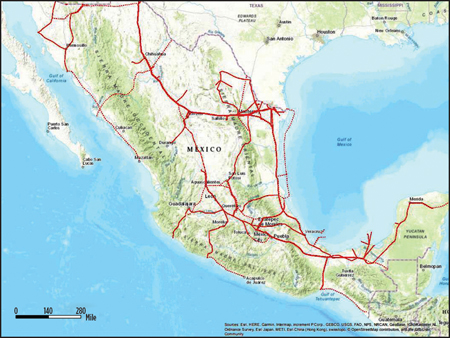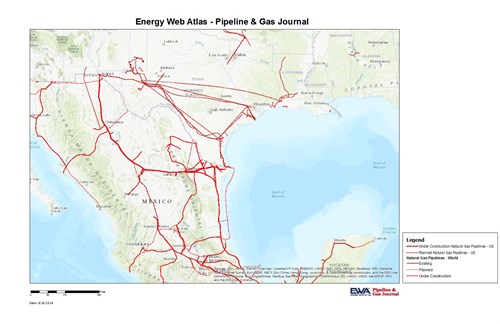Rising U.S. natural gas exports to Mexico capped by pipe delays
(Reuters) - U.S. natural gas exports to Mexico hit all-time highs this month, but a slower-than-expected build out of pipelines inside Mexico has kept increases far below available capacity at the border.
The latest uptick in exports, driven by demand from Mexico's power sector, occurred after several Mexican pipelines began operation, allowing U.S. companies to send more fuel across the border, RBN Energy said in a report.
Over the last decade, U.S. gas exports to Mexico via pipeline have more than tripled, to 4.9 billion cubic feet per day (bcfd) in August, according to Thomson Reuters data. One billion cubic feet is enough gas to fuel about five million U.S. homes. Still, that is less than half the available U.S. gas pipeline capacity to Mexico, which will increase to 13.5 bcfd by year-end when Enbridge Inc's $1.6 billion Valley Crossing pipeline enters service.
 |
| Mexico’s existing pipeline network. Source: EWA |
"There are a lot of projects to get gas across the border, but a lot of these are dependent on important lines within Mexico," said Rick Margolin, a senior analyst at energy data provider Genscape.
The completion of those pipelines on the Mexican side of the border are facing at least a year's delay on average, according to Genscape. The U.S.-Mexico Nueva Era project, which includes the Impulsora pipeline in Texas, was originally expected to enter service in mid-2017 but did not become operational until mid-2018 due to construction delays on the
Mexico side of the border.
 |
| Existing, Planned and Under Construction Source: EWA |
With gas pipelines constrained, Mexico has had to rely on more expensive liquefied natural gas (LNG) imports.
Mexico has been the biggest buyer of U.S. LNG, purchasing about 19 percent of all U.S. cargoes between February 2016 and May. Mexico is on track to import 188.9 billion cubic feet of U.S. LNG in 2018. That was up from 140.3 bcf in 2017, which was worth about $695 million, and 27.4 bcf in 2016.
As more pipelines enter service, analysts expect cheaper U.S. gas via pipeline will displace the more expensive LNG imports. Completion of more infrastructure in Mexico will also enable more U.S. gas to flow out of the pipeline-constrained Permian basin in west Texas and eastern New Mexico, which is producing record amounts of cheap gas as a byproduct of oil drilling. (Reporting by Andres Guerra Luz and Scott DiSavino in New YorkEditing by Susan Thomas)
READ MORE: Mexico’s continuing energy reform feeds pipeline, LNG aspirations

- ExxonMobil halts 1-Bft3d blue hydrogen project in Texas
- Aramco and Yokogawa commission multiple autonomous control AI agents at Fadhili gas plant
- Ukraine will resume gas imports via Transbalkan route in November
- Mitsubishi to inject $260 MM into Brunei LNG project
- Freeport LNG (U.S.) on track to take in more natgas on Thursday after unit outage



Comments